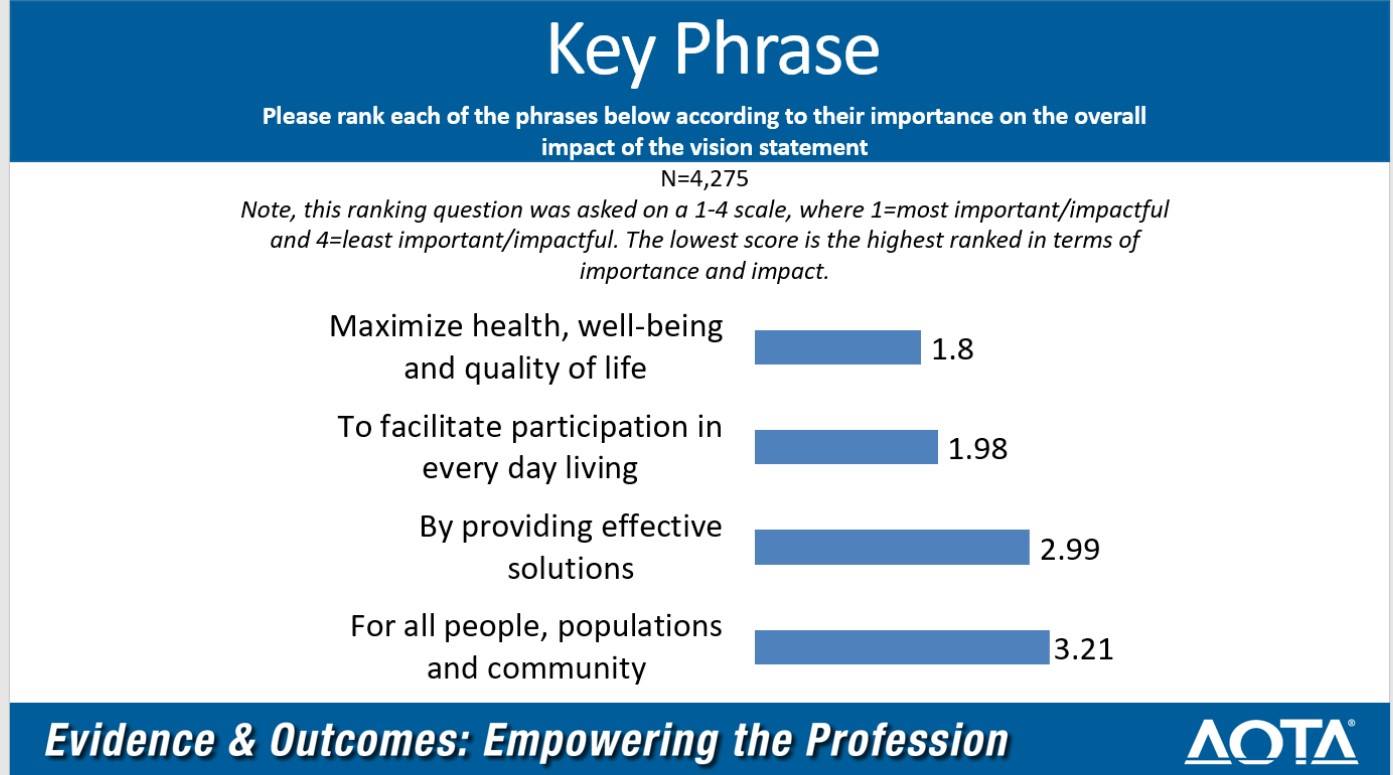|
It’s been a while since I have written a blog post. Work and life in general have been keeping me pretty busy, and frankly world and national affairs have made me want to stick my head in the sand. I've felt a little blah. However, this is something I care about deeply, so I’m baaaaaaaack! Dear AOTA Members, You currently have the opportunity to give feedback on the draft of an official paper on “Occupational Therapy’s Role in Population Health.” Population health is central to AOTA’s Vision 2025 statement. The vision statement is: “Occupational therapy maximizes health, well-being, and quality of life for all people, populations, and communities through effective solutions that facilitate participation in everyday living.” Giving input and feedback on official documents is one simple way that every member of AOTA can play an active role in guiding the future of our association and our profession. I have a strong investment in occupational therapy practitioners addressing population health as one part of our varied practice. I took the time to organize and present my ideas in an article available in open access in the American Journal of Occupational Therapy titled, “Population Health and Occupational Therapy. You can access the article here: https://ajot.aota.org/article.aspx?articleid=2478827&resultClick=3 I was honored to be invited to participate as a presenter at an institute on population health at the 2017 Annual Conference & Exhibition and was instrumental in starting a discussion on population health on OTConnections. AOTA members can read that discussion here: https://otconnections.aota.org/sis_forums/f/7926.aspx I was fortunate to be serving on the Board of Directors of AOTA during the development of the Vision 2025 statement and am extremely proud of the extensive process we used to develop the statement and get feedback. Here is a brief description of the process located on the AOTA Website. “In 2014, AOTA began the new visioning process by retaining McKinley and Associates to solicit and organize input from within the profession and from outside stakeholders. This included broad-based surveys to more than 60,000 member and nonmembers, and interviews with industry leadership, all seeking insight on the profession’s challenges, strengths, and potential goals. McKinley reported their findings at the AOTA Vision Summit, held in October 2015. The Summit brought together just fewer than 100 AOTA staff and volunteer participants, invited to represent a broad range of age, experience, diversity, and practice settings. Over 2 days, the group reviewed McKinley’s research, and also discussed pertinent societal trends and potential changes shifts in health care. The Summit concluded with defined “essential elements” and three drafts of a possible new vision statement. Those drafts were vetted and distilled into a single statement, which was sent to 58,000 practitioners and students, who responded with a 78% approval rating. The Board adopted and approved Vision 2025 at their February meeting” (AOTA, 2016). It is understandable and predictable that not every occupational therapy practitioner and not every member of AOTA supports this statement. But the fact that 78% of those who responded to the survey rated the vision statement as favorable or highly favorable is significant. If you are not yet familiar with population health as area of intervention for occupational therapy practitioners it is important that you take the time to learn about it and form an independent position. I’ve shared my thinking (in my AJOT article) and encourage you to listen to the viewpoints of others, including those who disagree with me. It is important also that you question the validity of information that is presented. For example I recently saw this slide posted on social media. It reflects the results of one question from the survey sent to 58,000 practitioners and students. The question was “Please rank each of the phrases below according to their importance on the overall impact of the vision statement.” The inference presented on social media seemed to be that the results of this question indicate that the respondents did not think that the phrase “for all people, populations and community” was important. But of course we don’t know that. What we know is that when presented a forced ranking option the key phrase “for all people, populations and community” was less important than three other key phrases in the Vision 2025 Statement. If the same respondents were asked to rank each of the four key phrases along a continuum of very important to not at all important, it is possible that many of them would rank all four key phrases as important to the overall impact of the vision statement. Given that 78% of survey respondents rated the vision statement as favorable or highly favorable I don’t believe they had a negative reaction to any of the key phrases.
I was in the room at the Board of Directors meeting when the representatives of McKinely Associates reviewed the process for developing the statement and for review of stakeholder feedback including the survey and focus groups with almost every leadership body in the Association. The results and positive response to Vision 2025 were compelling. Any suggestion that AOTA has moved forward without listening to its members has no grounding in reality or fact. Again, if you are an AOTA member I highly encourage you to visit the AOTA website and read about Vision 2025 and population health. I encourage you to read the draft statement on the role of occupational therapy and population health and provide feedback. Thank you! American Occupational Therapy Association. (2016). AOTA Unveils Vision 2025. Online at: https://www.aota.org/AboutAOTA/vision-2025.aspx
0 Comments
Your comment will be posted after it is approved.
Leave a Reply. |
The opinions expressed in my blog are personal and neither represent the views of my employer nor any organization.
Archives
July 2023
Categories |



 RSS Feed
RSS Feed